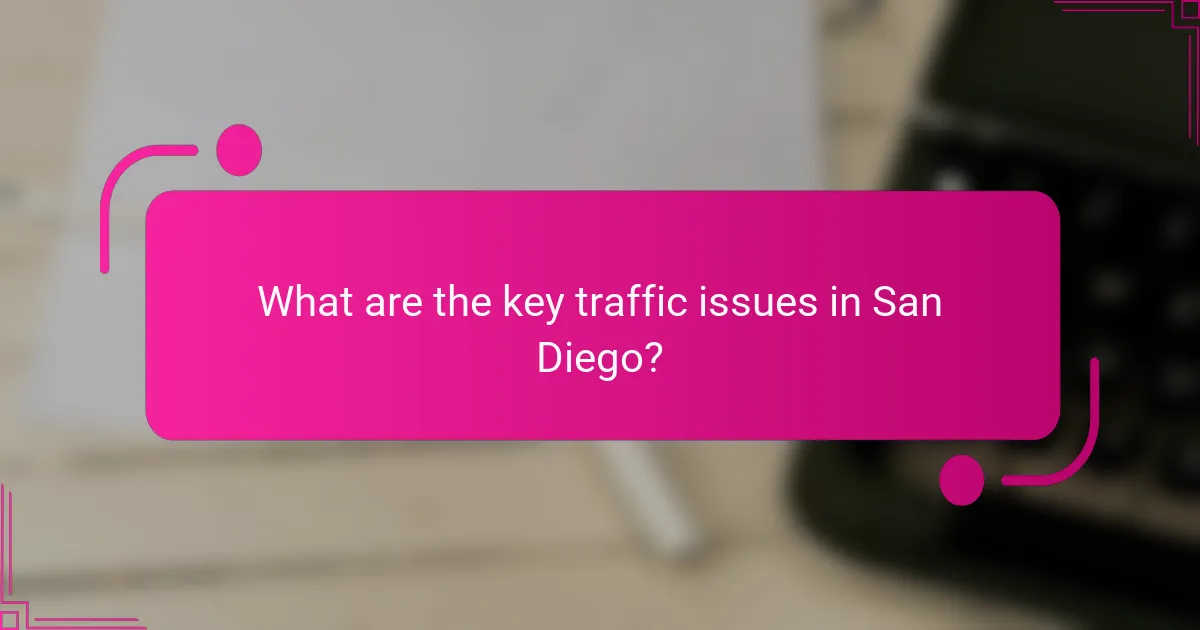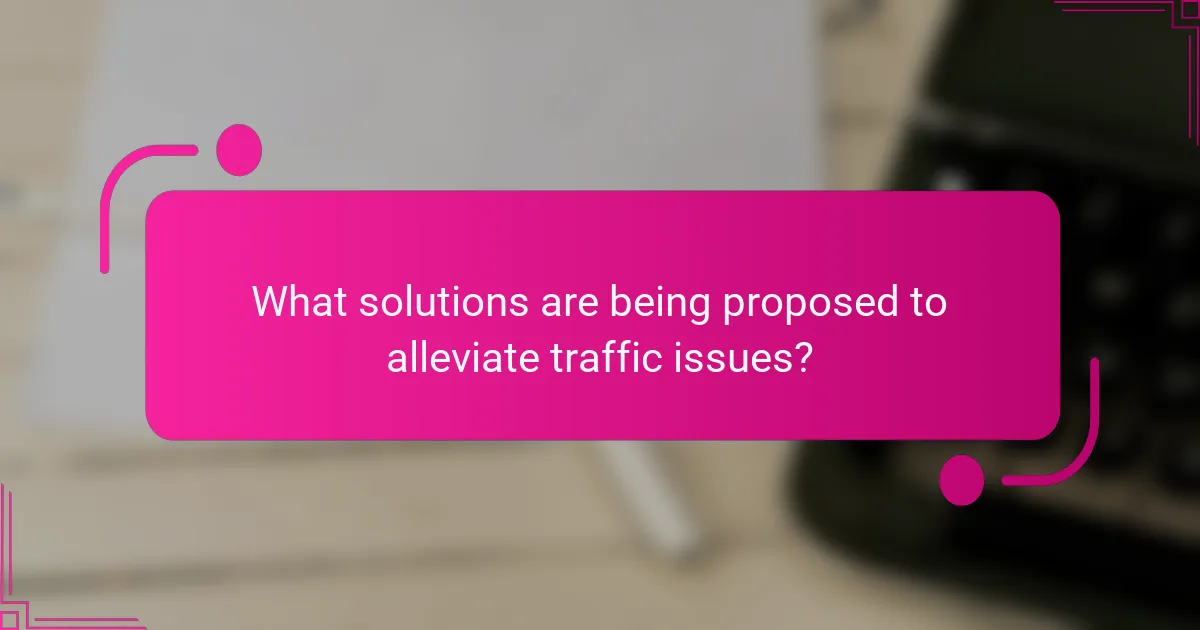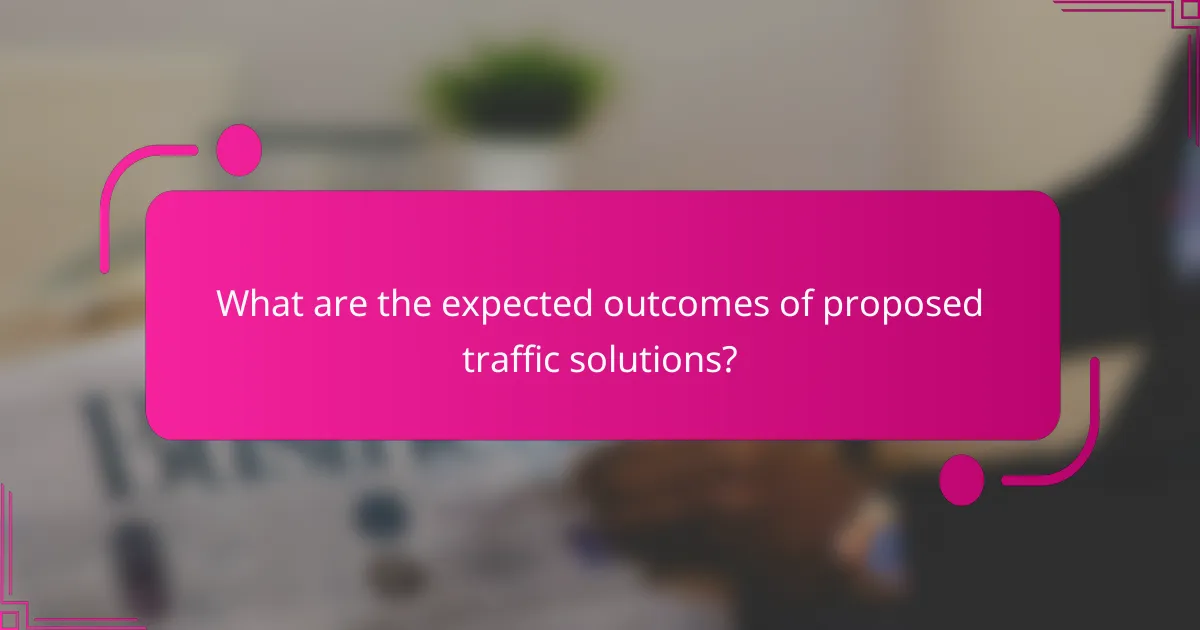
What are the key traffic issues in San Diego?
Key traffic issues in San Diego include congestion, inadequate public transit, and limited road infrastructure. Congestion is particularly severe during rush hours, with significant delays reported on major highways like I-5 and I-15. Inadequate public transit options lead to increased reliance on personal vehicles. This exacerbates traffic problems, as many areas lack efficient bus or rail services. Additionally, limited road infrastructure fails to accommodate the growing population. According to the San Diego Association of Governments, traffic delays cost the region approximately $1.5 billion annually. These factors collectively contribute to the ongoing traffic challenges faced by residents and commuters in San Diego.
How do traffic congestion patterns manifest in San Diego?
Traffic congestion patterns in San Diego manifest primarily during peak commuting hours. Morning congestion typically occurs between 7 AM and 9 AM. Evening congestion peaks from 4 PM to 6 PM. Major highways, such as Interstate 5 and Interstate 805, often experience significant delays. Specific bottlenecks are common near downtown and major interchanges. Traffic congestion is exacerbated by special events and road construction. According to the Texas A&M Transportation Institute, San Diego ranks among the top 25 metropolitan areas in the U.S. for traffic congestion. The average commuter spends over 100 hours annually in traffic delays. These patterns indicate a need for improved infrastructure and public transportation options.
What areas experience the most severe traffic congestion?
Downtown San Diego experiences the most severe traffic congestion. This area is a hub for business, tourism, and events. Major roads like Interstate 5 and State Route 163 converge here. During peak hours, traffic volume significantly increases. The Gaslamp Quarter and surrounding neighborhoods are particularly affected. Studies indicate that rush hour congestion can lead to delays of over 30 minutes. Additionally, events at the San Diego Convention Center exacerbate traffic issues. Traffic patterns show that weekends also see increased congestion due to recreational activities.
How do peak hours affect traffic flow in the city?
Peak hours significantly slow down traffic flow in the city. During these times, the volume of vehicles on the road increases sharply. This leads to congestion and longer travel times. Studies show that traffic speeds can drop by up to 50% during peak hours. Traffic signals and intersections become more strained, causing delays. Additionally, public transportation systems can experience overcrowding. The effects are often most pronounced in densely populated areas. This pattern is consistent across many urban environments, including San Diego.
What are the primary causes of traffic issues in San Diego?
The primary causes of traffic issues in San Diego include high population density, inadequate public transportation, and road infrastructure limitations. High population density leads to increased vehicle usage, resulting in congestion. Inadequate public transportation options force more people to rely on cars. Limited road infrastructure struggles to accommodate the growing number of vehicles. Additionally, frequent road construction and maintenance contribute to delays. Traffic accidents also play a significant role in disrupting flow. Seasonal tourism increases traffic volume during peak times. These factors collectively create significant traffic challenges in the city.
How does population growth impact traffic conditions?
Population growth significantly worsens traffic conditions. As more people move to an area, the number of vehicles on the road increases. This leads to congestion during peak travel times. According to the San Diego Association of Governments, San Diego County’s population increased by over 100,000 from 2010 to 2020. This growth directly correlates with longer commute times and more traffic jams. More residents also lead to higher demand for public services, including transportation infrastructure. Insufficient road capacity cannot accommodate the rising number of vehicles. Consequently, traffic delays and accidents become more frequent.
What role do road infrastructure and public transportation play?
Road infrastructure and public transportation are critical for urban mobility and economic development. They facilitate the movement of people and goods within a city. Well-maintained roads reduce travel time and vehicle operating costs. Public transportation systems provide affordable alternatives to private vehicles. They help decrease traffic congestion and lower greenhouse gas emissions. In San Diego, a robust public transit network can enhance accessibility for residents. According to the American Public Transportation Association, public transit saves individuals an average of $10,000 annually. Improved road infrastructure can lead to increased property values and local business growth.
Why is community feedback important in addressing traffic issues?
Community feedback is important in addressing traffic issues because it provides insights from those directly affected. Residents experience daily traffic conditions and can identify specific problems. Their feedback helps authorities prioritize areas needing improvement. For example, studies show that community input can lead to more effective traffic management solutions. Engaging with the community fosters a sense of ownership and accountability. Additionally, feedback can highlight unique local concerns that data alone might miss. This collaborative approach leads to more sustainable traffic solutions. Ultimately, addressing traffic issues effectively requires understanding the community’s perspective.
How do residents perceive current traffic conditions?
Residents perceive current traffic conditions in San Diego as congested and frustrating. Many report long commute times, especially during peak hours. According to a recent survey, 70% of residents express dissatisfaction with traffic flow. Traffic jams are common on major routes, leading to increased travel times. Additionally, some residents feel that public transport options are insufficient. This perception has led to calls for improved infrastructure and alternative transportation solutions. Local news reports indicate that traffic-related complaints have risen by 15% over the past year. Overall, residents view traffic conditions as a significant issue affecting their daily lives.
What suggestions have community members made for improvements?
Community members have suggested several improvements to address traffic issues in San Diego. They recommend increasing public transportation options to reduce reliance on cars. Enhanced bike lanes and pedestrian pathways are also advocated for safer travel. Implementing synchronized traffic signals can help improve traffic flow. Many community members support the idea of carpooling incentives to decrease vehicle numbers on the road. Increased signage and clearer road markings are suggested for better navigation. Additionally, some residents propose expanding road capacity in high-traffic areas to alleviate congestion. These suggestions reflect a community-driven approach to finding effective solutions for local traffic challenges.

What solutions are being proposed to alleviate traffic issues?
Proposed solutions to alleviate traffic issues in San Diego include expanding public transportation options. This encompasses increasing bus and trolley services to reduce reliance on personal vehicles. Implementing dedicated bike lanes is another suggested approach. This aims to encourage cycling as a viable alternative for short trips. Additionally, improving traffic signal synchronization can enhance vehicle flow. This adjustment is designed to minimize congestion at key intersections. Promoting carpooling initiatives is also under consideration. This strategy seeks to decrease the number of single-occupancy vehicles on the road. Finally, enhancing infrastructure for electric vehicles is proposed. This includes expanding charging stations to support a transition to cleaner transportation.
How is the city planning to improve public transportation?
The city plans to improve public transportation by expanding bus routes and increasing service frequency. This initiative aims to enhance accessibility for residents. Additionally, the city is investing in infrastructure upgrades, such as dedicated bus lanes. These improvements are expected to reduce travel time and congestion. The city has also proposed integrating a light rail system to connect key areas. Community feedback has indicated strong support for these enhancements. Studies show that improved public transit can lead to a 20% increase in ridership. These measures reflect the city’s commitment to addressing traffic issues effectively.
What new transit projects are currently under development?
San Diego is currently developing several new transit projects. The Mid-Coast Trolley extension is one significant project. It will extend the Blue Line trolley from Old Town to University City. This extension aims to improve access to key areas and reduce traffic congestion. Another project is the Downtown Mobility Plan, which focuses on enhancing pedestrian and bicycle infrastructure. The San Diego International Airport is also undergoing improvements to its transit connections. These projects aim to create a more integrated and efficient transit system in the region.
How can public transportation usage be increased among residents?
Public transportation usage can be increased among residents by improving accessibility and reliability. Enhancements to bus and train schedules can reduce wait times. Expanding routes to underserved areas can also attract more users. Implementing affordable fare options encourages ridership. Providing real-time tracking through mobile apps enhances user experience. Community outreach programs can raise awareness about public transportation benefits. Studies show cities with improved public transport see a 10-20% increase in ridership. Engaging local businesses in promoting transit can further boost usage.
What role does technology play in managing traffic flow?
Technology plays a crucial role in managing traffic flow. It enhances efficiency through real-time data collection and analysis. Systems like traffic signals adapt based on current conditions. Intelligent Transportation Systems (ITS) use sensors to monitor traffic patterns. These systems can reduce congestion by optimizing signal timings. Additionally, GPS navigation apps provide drivers with alternate routes. Studies show that technology can decrease travel time by up to 20%. Furthermore, traffic cameras assist in monitoring and managing incidents quickly. Overall, technology significantly improves traffic management and safety.
How are smart traffic signals being implemented?
Smart traffic signals are being implemented through advanced technology that optimizes traffic flow. These signals use real-time data from sensors and cameras to adjust signal timings. They analyze traffic patterns and congestion levels continuously. The implementation includes integrating with existing infrastructure for seamless operation. Cities like San Diego are adopting these systems to reduce wait times and improve safety. Studies show that smart signals can reduce travel times by up to 20%. This technology also helps decrease emissions by minimizing idling. Overall, smart traffic signals represent a significant advancement in urban traffic management.
What innovations in traffic monitoring are being utilized?
Innovations in traffic monitoring include the use of smart sensors and real-time data analytics. Smart sensors can detect vehicle counts, speed, and types of vehicles on roads. These sensors provide accurate traffic flow information. Real-time data analytics processes this information to optimize traffic signals. This reduces congestion and improves travel times. Additionally, mobile applications provide users with live traffic updates. These innovations are increasingly adopted in urban areas like San Diego to enhance traffic management. Studies show that cities implementing these technologies see a significant decrease in traffic delays.

What are the expected outcomes of proposed traffic solutions?
Proposed traffic solutions in San Diego are expected to reduce congestion and improve travel times. These solutions aim to enhance the efficiency of road networks. Implementing smart traffic signals can optimize traffic flow. The introduction of dedicated bus lanes is projected to encourage public transit use. Improved bike lanes may promote cycling as a viable transportation option. Enhanced pedestrian infrastructure is likely to increase walkability in urban areas. Studies indicate that such measures can lead to a decrease in vehicle emissions. According to the San Diego Association of Governments, effective traffic management can improve overall air quality.
How will traffic improvements affect daily commuters?
Traffic improvements will reduce commute times for daily commuters. Enhanced road infrastructure leads to smoother traffic flow. This minimizes congestion during peak hours. A study by the Texas A&M Transportation Institute shows that improved road conditions can decrease travel times by up to 20%. Additionally, better traffic management systems can optimize signal timings. This further enhances the efficiency of road usage. Improved traffic conditions lead to less vehicle idling. Consequently, this reduces fuel consumption and emissions. Overall, traffic improvements significantly benefit daily commuters by making their travel more efficient and less stressful.
What benefits can residents expect from reduced congestion?
Residents can expect improved air quality from reduced congestion. Less traffic leads to lower vehicle emissions. This results in fewer pollutants in the atmosphere. Improved air quality can enhance public health. Residents may experience fewer respiratory issues and allergies. Reduced congestion also leads to shorter travel times. This can increase productivity and decrease stress levels. Studies indicate that efficient traffic flow can boost local economies. Overall, reduced congestion provides multiple benefits for residents’ quality of life.
How can improved traffic conditions enhance local businesses?
Improved traffic conditions can enhance local businesses by increasing customer accessibility. When traffic flows smoothly, more potential customers can reach businesses without delays. This leads to higher foot traffic and increased sales opportunities. A study by the Texas A&M Transportation Institute found that reduced congestion can boost local retail sales by up to 15%. Additionally, improved traffic conditions can enhance delivery efficiency for businesses, reducing operational costs. As a result, local businesses can experience growth and profitability from a more accessible environment.
What challenges might arise during the implementation of solutions?
Challenges during the implementation of traffic solutions in San Diego include funding shortages. Limited financial resources can hinder project initiation and completion. Another challenge is community opposition. Residents may resist changes due to concerns about disruption or alterations to their neighborhoods. Additionally, coordination among multiple agencies can pose difficulties. Different governmental bodies may have conflicting priorities and timelines. Technical feasibility is another concern. Proposed solutions may encounter unexpected engineering challenges. Finally, public awareness and engagement are crucial. Lack of information can lead to misunderstandings about the benefits of proposed solutions.
How can community involvement help overcome these challenges?
Community involvement can significantly help overcome San Diego’s traffic challenges. Engaging residents fosters collaboration among stakeholders. This collaboration can lead to more effective traffic management solutions. For example, community input can identify problem areas that may be overlooked by authorities. Involving citizens in planning processes can enhance public transit options. Studies show that cities with active community participation see improved traffic flow. Moreover, community-led initiatives can promote carpooling and alternative transportation methods. This collective effort can reduce congestion and improve overall road safety.
What are some best practices for residents to adapt to traffic changes?
Residents can adapt to traffic changes by staying informed about local traffic updates. They should utilize apps and websites that provide real-time traffic information. Planning trips during off-peak hours can help avoid congestion. Familiarizing themselves with alternative routes is essential for reducing travel time.
Participating in community meetings can provide insights into upcoming changes. Residents should also consider carpooling or using public transportation to decrease the number of vehicles on the road. Engaging with local traffic authorities can facilitate better understanding of traffic patterns.
Research indicates that communities that actively share traffic information experience smoother transitions during changes. According to a study by the Institute of Transportation Engineers, informed residents are more adaptable and less likely to experience frustration during traffic adjustments.
San Diego Traffic Issues encompass key challenges such as congestion, inadequate public transit, and limited road infrastructure. The article examines the patterns of traffic congestion, particularly during peak hours, and identifies areas most affected, including downtown San Diego. It discusses the primary causes of traffic problems, including population growth and insufficient transportation options, and explores proposed solutions such as expanding public transit and implementing smart traffic signals. Community feedback is highlighted as essential for addressing these issues, with residents suggesting various improvements to enhance traffic flow and accessibility.